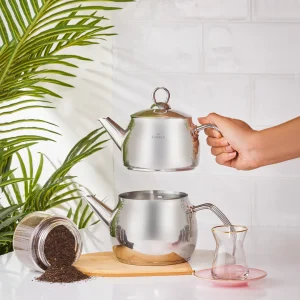
How to make turkish tea with double teapot
Introduction: A Taste of Turkey in Every Sip
- Introduction: A Taste of Turkey in Every Sip
- Our top picks
- What Makes Turkish Tea Unique
- Understanding the Double Teapot
- Choosing the Best Black Tea
- Step-by-Step Guide: How to Make Authentic Turkish Tea
- The Story Behind Turkish Tea Culture
- Key Features of the Turkish Bouble Teapot
- Craftsmanship and Materials
- Why Turkish Tea is Perfect for Family Gatherings
- Health Benefits of Turkish Tea
- Top Tips for Brewing Perfect Turkish Tea
- Product Specifications
- Comparing Turkish Tea to Other Global Tea
- Your Questions, Answered
- Pros and Cons
Turkish tea is more than just a beverage; it’s a cultural experience that brings friends and family together. The unique brewing process using a double teapot creates a rich and fragrant cup of tea that is enjoyed across Turkey, particularly in bustling cities like Istanbul. This article will guide you through the art of making Turkish tea with a double teapot, exploring its distinctive characteristics and the essential tools required. Whether you’re a seasoned tea drinker or a newcomer to this delightful tradition, you’ll learn how to brew the perfect cup of strong Turkish tea that captures the essence of Turkey in every sip.
Our Top Picks

Karaca Belinay Stainless Steel Teapot Set, Medium, Silver
The Silver Karaca 3D Stainless Steel Induction Teapot Set is ready for you at the competitive price of 59.99 GBP and with Karaca's guarantee.

Karaca Kayra Black Turkish Teapot Set
Tea is a necessary component of breakfast, lunch, leisure time, and after-dinner tea. We place a high value on tea that is both excellent and fresh because of this.

Karaca Adelya Black Teapot Set Small Size
A traditional stainless steel teapot that uses the samovar principle—that is, tea bags—to brew scented black or green tea.

Karaca Retro Enamel Induction Teapot Set, Red
The Red Karaca Retro Enamel Induction Teapot Set is ready for you at the competitive price of 34.99 GBP and with Karaca's guarantee.

Karaca Edge Mini Teapot Set Black
Set of Black Karaca Edge Mini Induction Teapots. With a 1.5-liter water reservoir and a 1-liter teapot, the Karaca Edge Mini Induction Teapot Set lets you make tea in the precise setting and flavor you want.

Karaca Retro Enamel Induction Teapot Set, Anthracite
With the guarantee of Karaca and the attractive price of 34.99 GBP, the Karaca Retro Enamel Induction Teapot Set, Anthracite, is ready for you.

Karaca Adelya Metal Teapot Set Small Size
Small Size Karaca Adelya Metal Teapot Set. With the Karaca Adelya Mini Size Teapot Set, you can fully customize the flavor and quantity of tea you brew. It comes with a 1.1-liter and a 0.65-liter teapot.

Karaca Edena Midi Teapot Set Red
The red midi teapot set from Karaca Edena. Steel is the material. Induction-suitable. capacity. 1.5-liter teapot. Two-liter kettle
What Makes Turkish Tea Unique?
Turkish tea stands out due to its unique preparation method and robust flavor profile, primarily derived from the black tea leaves used. Unlike many other tea cultures, Turkish tea is characterized by its strong, concentrated nature, achieved through a careful brewing process. The use of a double teapot allows for precise temperature control, enabling the tea to steep to perfection. Moreover, the cultural significance of sharing tea in Turkey adds to its uniqueness, as it is often served alongside conversations and gatherings, fostering a sense of community. This communal aspect, combined with the distinctive brewing method, ensures that every cup of Turkish tea tells a story of tradition and hospitality.
Understanding the Double Teapot
The double teapot, or “çaydanlık,” is a traditional Turkish kettle that consists of two stacked pots. The bottom pot holds water, which is brought to a boil, while the upper pot contains the tea leaves. This method allows for a precise brew, where the strong tea from the top pot can be diluted with the hot water from the bottom pot according to personal taste. The design of the double teapot not only enhances the brewing process but also serves as an elegant centerpiece during tea gatherings. The craft behind the double teapot reflects the rich history of Turkish tea culture, emphasizing the importance of both functionality and aesthetics in its design.
Choosing the Best Black Tea
When it comes to making Turkish tea, selecting the right black tea is crucial for achieving the desired flavor and aroma. High-quality Turkish tea, typically sourced from the Rize region along the Black Sea, is known for its robust and full-bodied flavor. Look for loose tea leaves rather than tea bags, as they allow for better infusion and a richer taste. When brewing, a general rule of thumb is to use about one tablespoon of tea leaves for each cup of water. This ensures a strong brew that can be diluted to suit individual preferences. Investing in high-quality black tea elevates your Turkish tea experience, ensuring every sip is delightful.
Step-by-Step Guide: How to Make Authentic Turkish Tea
To make Turkish tea with a double teapot, start by filling the bottom pot, or kettle, with water, and place it on the stove to boil. While the water is boiling, add the tea leaves to the upper pot. Once the water reaches a rolling boil, pour some of the boiling water over the tea leaves in the upper pot, and let it steep for about 10-15 minutes. This process allows the tea to develop its strong flavor. After steeping, pour the brewed tea from the top pot into a tea glass, and dilute it with hot water from the bottom pot according to your taste. This method ensures that you have rich, aromatic Turkish tea ready to enjoy.
The Story Behind Turkish Tea Culture
The story of Turkish tea culture is deeply intertwined with the country’s history and social fabric. Tea was first introduced to Turkey in the 19th century, quickly becoming a staple in daily life. Its consumption evolved into a cherished ritual, often associated with hospitality and friendship. In homes and cafes across Turkey, tea is served as a gesture of warmth and welcome, reflecting the country’s values of generosity and community. The process of making and sharing tea fosters connections among people, turning simple moments into lasting memories. Today, Turkish tea continues to be an integral part of social gatherings, symbolizing the rich heritage and traditions of Turkey.
Key Features of the Turkish Double Teapot
The Turkish double teapot, or çaydanlık, boasts several key features that enhance the brewing experience. Its dual-pot design allows for simultaneous boiling and steeping, making it efficient and practical. The upper pot is typically smaller, designed to hold the concentrated tea, while the larger bottom pot contains the boiling water. This design allows users to control the strength of their tea by adjusting the ratio of brewed tea to hot water. Additionally, the teapot is often made from materials like stainless steel or ceramic, which provide durability and heat retention. The aesthetic appeal of the double teapot also adds a touch of elegance to any tea service, making it a cherished item in Turkish households.
Craftsmanship and Materials
The craftsmanship of Turkish double teapots is a testament to the country’s rich heritage of metalwork and ceramics. Traditionally, these teapots are made from high-quality materials such as copper, stainless steel, and porcelain, each offering unique aesthetic and functional benefits. The intricate designs often feature traditional Turkish motifs, enhancing their beauty and making them a focal point during tea gatherings. Skilled artisans take great care in creating these teapots, ensuring that each piece is not only visually appealing but also efficient in brewing tea. This commitment to artistry and quality ensures that the Turkish double teapot is both a functional tool and a work of art, embodying the culture’s dedication to craftsmanship.
Why Turkish Tea is Perfect for Family Gatherings
Turkish tea is perfectly suited for family gatherings due to its cultural significance and communal nature. Serving tea in Turkey is more than just offering a drink; it’s a way to foster connection and share experiences. The process of brewing tea together creates an atmosphere of togetherness, inviting conversations and laughter. Additionally, the versatility of Turkish tea, from strong brews to lighter dilutions, allows for customization to suit everyone’s taste, making it an inclusive choice for all guests. Moreover, the tradition of serving tea in small, elegant tea glasses enhances the experience, making every sip special. This shared ritual of enjoying tea strengthens bonds and creates lasting memories during family gatherings.
Health Benefits of Turkish Tea
Turkish tea offers numerous health benefits that contribute to its popularity. Rich in antioxidants, black tea can help combat oxidative stress and improve overall health. Regular consumption may also enhance heart health by supporting better blood circulation and reducing cholesterol levels. Additionally, the caffeine content in Turkish tea provides a gentle energy boost and can improve focus and concentration. Enjoying Turkish tea can also promote hydration, especially when consumed without excessive sugar. With its rich flavor and health benefits, Turkish tea is not only a delightful beverage but also a wise choice for a healthy lifestyle.
Top Tips for Brewing Perfect Turkish Tea
To brew the perfect cup of Turkish tea, start with high-quality black tea leaves, as their flavor plays a crucial role in the final result. Always use fresh, cold water for boiling, as this enhances the tea’s taste. When filling the bottom pot, ensure you have enough water to maintain a steady boil throughout the brewing process. After adding the tea leaves to the upper pot, pour boiling water over them to initiate the steeping process. Allow the tea to steep for 10-15 minutes for optimal flavor. Finally, remember to adjust the strength of your tea by diluting it with water from the bottom pot, catering to individual preferences. Following these tips will help you master the art of making Turkish tea with a double teapot.
Product Specifications:
- Manufacturer: Karaca Azir Glass Teapot Set, Transparent
- Origin: UK
- Brand: Karaca
- Material: Glass
- Set Content: Teapot & Lid (0.65L)
Tea Kettle (1.5L) - Suitability: Dishwasher Safe
- Garuantee: 2 Years
Comparing Turkish Tea to Other Global Tea
Turkish tea differs significantly from other global tea varieties in terms of preparation, flavor, and cultural significance. While many tea cultures focus on delicate flavors and precise brewing methods, Turkish tea is known for its bold and robust nature, primarily due to the use of strong black tea leaves. The double teapot brewing method is unique to Turkey, allowing for a rich concentration of flavor that can be tailored to individual preferences. In contrast, countries like Japan emphasize minimalist approaches with matcha and green teas. Additionally, the social aspect of tea in Turkey, where it is often served in small glasses during gatherings, sets it apart from other cultures that may use more formal tea settings. This comparison highlights the rich diversity of tea traditions around the world.
Your Questions, Answered
How to Use and Maintain Your Teapot
Using and maintaining your Turkish double teapot is essential for ensuring longevity and optimal performance. To use the teapot, fill the bottom pot with water and place it on the heat source. Add tea leaves to the upper pot and allow the tea to steep once the water boils. After brewing, clean your teapot with warm soapy water, avoiding abrasive materials that could scratch the surface. Regularly check for any buildup of tea stains and rinse thoroughly. Proper maintenance will keep your teapot in excellent condition, allowing you to enjoy perfectly brewed Turkish tea for years to come.
Pros
- Made from high-quality stainless steel, ensuring long-lasting performance and resistance to rust.
- Its sleek design adds elegance to any kitchen.
- Works on induction cooktops, enhancing versatility.
- Easy to clean, saving time and effort.
- Offers peace of mind with warranty support.
Cons
- No built-in tea filter, requiring additional accessories for loose tea.
- Some users might find this inconvenient.
- Limited capacity may not suit larger households.
- Stainless steel can show marks if not handled carefully
















